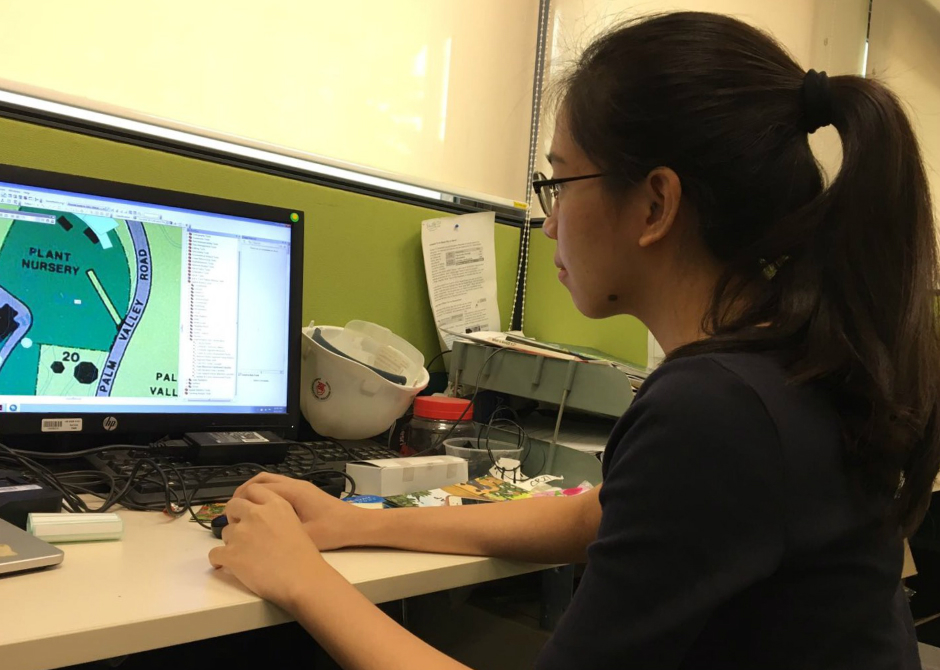Megan Chin inspected trees, assisted in landscaping efforts, and helped in national initiatives to enhance Singapore’s green recreational belts. She is no professional arborist or horticulturist, but a 17-year old on a 2-week work attachment with the National Parks Board (NParks).
By working in the field, young Geographers like Megan gain insights into real-world phenomena, and they learn to ask important questions about the world we live in. What is the relationship between humans and the natural environment? Why are some places so meaningful to certain communities? How are physical or human processes interrelated?
To nurture aspiring Geographers, the Geography Talent Development Programme by the Ministry of Education connects students with public agencies and industry associates for work stints. Pre-University Geography students in the programme would learn more about academic research, contemporary world issues, disciplinary interests, careers and fieldwork in Geography.
Facing real-world issues

Up close and personal with the operations of NParks, Megan and fellow Geography student Foong Ru Hui began to understand how their garden city came to be, and the greening initiatives required to intensify the integration of greenery with high density developments.
When participating in projects at the Singapore Botanic Gardens and Sungei Buloh Wetland Reserve, the realities of being in the working world also presented themselves. The best laid plans for a sustainable and liveable city could only be realised when people had the same perspective and mindset. They realised the importance of raising the “green consciousness” of Singaporeans in order to succeed.
Making a difference to local neighbourhoods
During a stint with the Urban Redevelopment Authority (URA), Neo Tung Yin and others had exclusive access to the in-depth knowledge about city building and the various planning regions in Singapore.
“My study in Geography allowed me to greater appreciate the work that went into the development of the Tampines Walking and Cycling Town by URA. Various measures were designed to cater to different stakeholders while maximising the limited land area and road space,” said Tung Yin, 17.
Alongside mentors from URA, they supported planning studies, collated ground information and prepared for public engagement, gaining insights on how urban strategies could improve the quality of living and increase inclusivity.
Tapping into the world’s knowledge
Hannah Quek, 17, learnt how information was organised, preserved and managed during her internship at the National Library Board (NLB). With this understanding, she was able to delve into the rich resources of the physical and digital collections, including the rare books.
For young Geographers, such a skill is vital, as it gives them access to knowledge and perspectives on contemporary and complex world issues. With an informed mind, they will be better able to make decisions and craft solutions to improve the world around them.
The stint may have been short, but Hannah focused on the topic of housing and early immigrants in Singapore and contributed to the authorship of the article series, “Looking at the Big Picture”.
Preparing for the era of technology
Technology and data has become a mainstay in workplaces, and it’s no different in Geography-related industries. During a job shadowing experience with the Geospatial Division at the Singapore Land Authority (SLA), Matthias Seah was introduced to Geographic Information Systems (GIS). He saw how data was used to visualise patterns and trends, how technologies were used for mapping and much more.
His experience also took him one step further, as he was able to see how data fed many policies, projects and initiatives.
“Everything has a certain need for geography – be it city planning, 3D mapping or healthcare planning, in which all require geospatial data,” exclaimed Matthias, 17.
Training minds for the demands of the future
Work stints help students to transit smoothly between school and work. When applied thoughtfully, the skills and knowledge learnt in the Geography classroom allow students to appreciate issues from multiple perspectives – making them to be highly sought after in the workplace.
Today, more than ever, there are a myriad of options for breaking into different work sectors. Continue supporting your child by helping to discover where his or her strengths and interests lie. Encourage him or her to dip a foot in the water to find out more and learn along the way.







